Have you ever wondered to yourself: "How do I know if I have termites?" Termites are small and difficult to detect, but they do leave some tell-tale signs. Read more about early warning signs of termites.

Contributed by: Doug Webb
Updated on: November 15, 2022
Found in 49 states (every state except Alaska), termites are a serious problem faced by homeowners nationwide. It's estimated that termites cause $5 billion in property damage each year. By protecting your home before you see signs of termites, you can potentially save money.
Termites feeding in your home can cause thousands of dollars in damage. Unfortunately, this type of damage is not usually covered by homeowners insurance.
If you've ever seen a single termite, it might seem improbable that they could cause that amount of damage. They're small, after all, normally only about a quarter of an inch to a half inch in length. But termites are not usually on their own. Instead, a single termite typically means a colony of potentially thousands of other termites are nearby. So while the damage that one termite can cause may be small, together, termites can cause significant damage to building structures.
Recognizing the signs of a termite infestation as early as possible is critical in treating termites and minimizing costly damage. Learn more about termite infestation signs and what a termite infestation looks like.
What is a termite infestation?
A termite infestation is when a colony of termites enters a residence or other structure. An infestation must be addressed quickly to avoid mounting damages to property.
A termite's diet primarily consists of cellulose, which is found in wood, paper and cardboard. In nature, termites help to clean up dead trees and other plant material, feeding off of the cellulose in these materials. However, when present in homes and structures, a termite's appetite for cellulose can cause serious damage.
What are the signs of a termite infestation?
Termites can become a damaging and expensive problem if you don't take care of them quickly. Left unchecked, they can damage the structural integrity of your home.
Be proactive about preventing termite damage by searching for signs of termites in your home or property on a periodic basis and maintaining a termite protection plan by a reputable company that includes an annual termite inspection.
Take a look at the top twelve signs of termite activity below:
1. Buckling or blisters in wood flooring
If you notice your wood flooring is buckling or has blisters in places, these areas could be an indication of termites feeding within or below. Subterranean termites can cause damage to the subfloor, which can make your wood flooring look discolored or have wavy appearance on the surface.
Termites prefer the softer wood of the subfloor or supports, so you may not notice their presence until they have done quite a bit of damage below the surface of your hardwood floors. Because more than one part of the flooring is involved, repairing a wood floor that has been damaged by termites can be difficult.
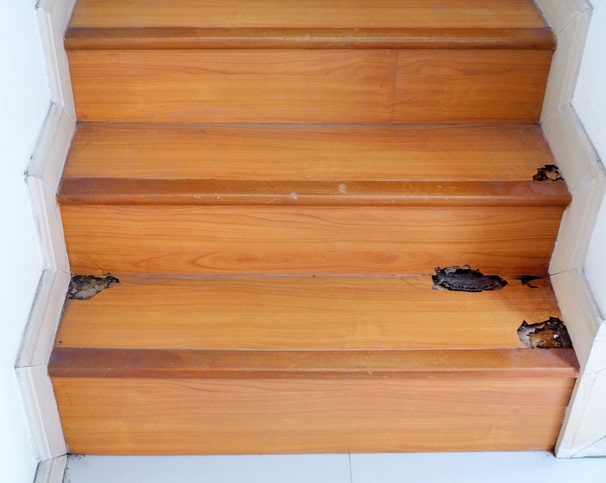
2. Hollowed or damaged wood
Wood damage can be found below and behind surfaces like walls, floors and more. Termites eat your walls from the inside out, which is why they can be difficult to spot. They will hollow out wood studs within walls without emerging, and these walls will sound empty when you tap on them.
Termites chew through wood to remove the cellulose, leaving behind long grooves. The grooves may resemble a maze inside your walls, or take the form of a honeycomb pattern. Over time, these grooves may weaken the wood and can create structural damage.
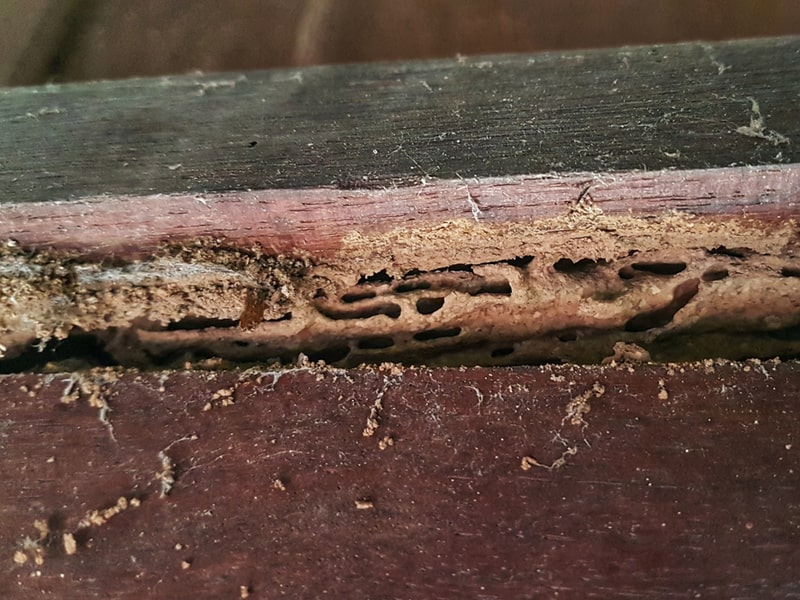
3. Swarmers (flying termites)
Swarmers are flying termites that branched off from their colony to find mates and begin a new colony. Swarming happens at certain times of year, and there may be hundreds or even thousands of flying termites in a swarm. If you notice a swarm of flying termites in or near your property, it is an indication that termites may have lived in the vicinity for several years.
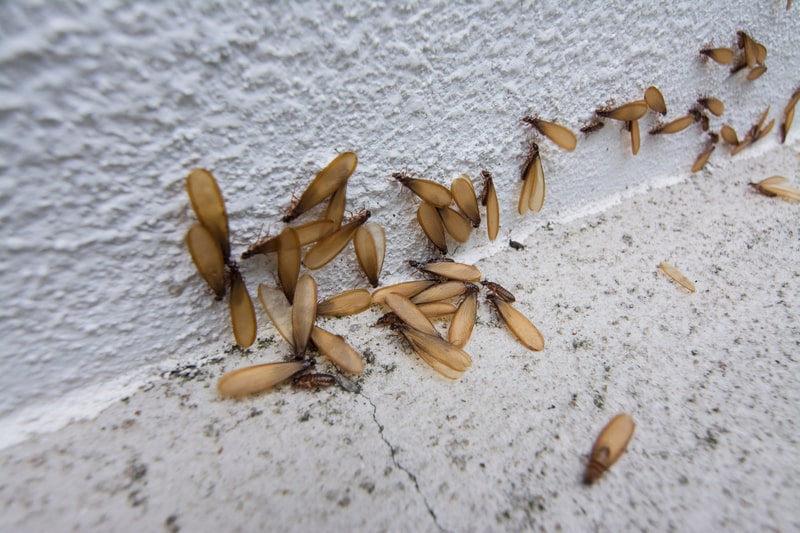
4. Discarded termite wings
Discarded termite wings can be found near closed windows, doors and other home-access points. Termites swarm out of their nest to mate and find a place to start a new colony. They fly toward the windows as they are attracted to the light from outdoors. When they land, termites intentionally twist their wings off because they won't need them again.
You may notice piles of these discarded wings. Just because their wings have been discarded does not mean the termites are dead. On the contrary, they may be busy trying to build a new colony nearby.
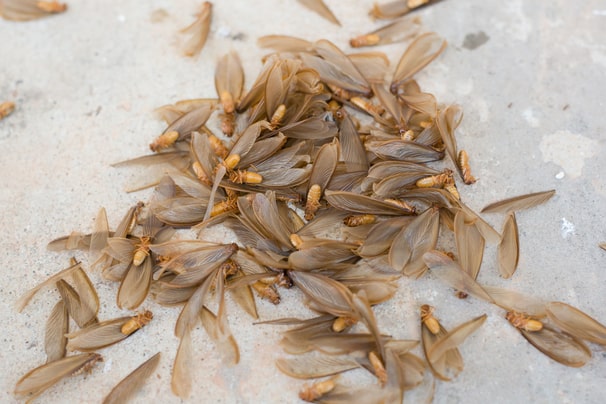
5. Hard to open doors and windows
When the termites eat through the wood in search of cellulose, they cause damage to the wood, causing it to buckle or warp. This damage can make it difficult for you to open and close your doors and windows. Stuck windows and doors that won't fully close could be early warning signs of a termite infestation.
6. Mud tubes
Pencil-sized mud tubes can be found wherever the ground meets your house or any other possible food source like a tree or shed when termites have entered the structure. This is because subterranean termites nest underground and forage up to their food source, which is often a house structure. These termites require certain temperatures and humidity levels to survive. Their tunnels help block out cool, dry air, effectively turning your home into an environment where they can thrive.
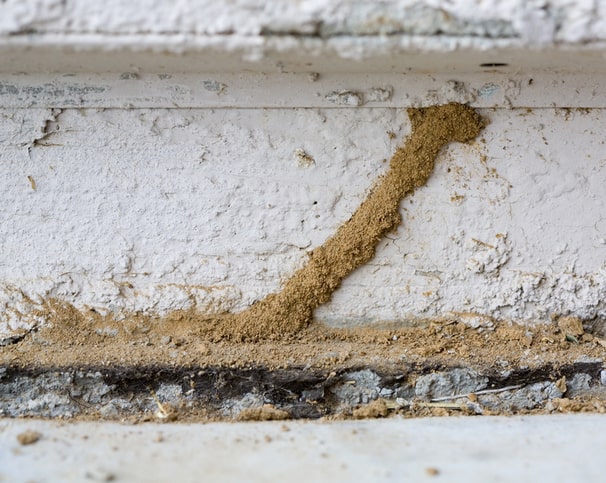
7. Drywood termite droppings (frass)
Drywood termites nest inside of wood. While tunneling and eating the wood they're infesting, they create galleries. To keep these galleries clean, they create kick out holes where they remove their excrement. And since drywood termites eat wood, their excrement is wood, and when they kick it out of their nest, it lands on window sills or floors and can create small mounds of pellets. These mounds of pellets, resembling sawdust or coffee grounds, may indicate the presence of drywood termites.
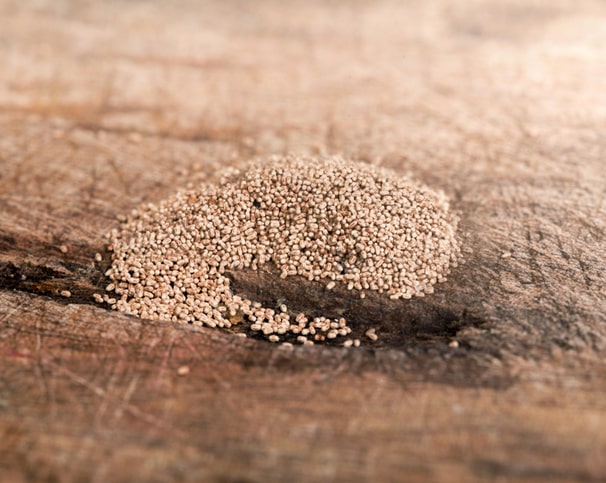
8. Live termites found during remodeling
If you're remodeling your home, keep an eye out for termites living in the wood you're tearing out. One of the most common ways termites are found in homes comes from renovations or remodeling. Taking down walls or cabinets, homeowners can be disappointed to find live termites. They can be found in the soil around your home, in rotting or damp wood components of your house, or anywhere on your property where they can feed on organic matter that contains cellulose such as tree stumps and firewood piles.
9. Damaged drywall, bubbling under paint or wallpaper
Drywall contains paper – and paper contains cellulose, which is a termite's primary source of food. As termites chew, they will leave behind small trails, both on the surface of and inside drywall. You may notice pin-sized holes in your drywall or wallpaper where the termites have eaten their way through. Termite pinholes in drywall are capped with a small speck of dirt and the presence of bubbling beneath your wallpaper or paint are visible indicators that termites are present.
10. Moldy scents
Termites like wood that is in high moisture situations, which usually includes moldy scents. If you notice a moldy smell and can't find the source, it is worth your time to call a professional for a termite inspection.
11. Dipping ceilings, buckling support beams or other severe structural damage
A termite infestation can cause damage to the structural elements of your building. Termites can eat through support beams, causing the beams to buckle, compromising the structural integrity of your home. For example, termite-damaged support beams can cause ceilings to dip and crack and floorboards to buckle. Their relentless tunneling can cause wood to fail. These damages can be very difficult – and costly – to repair.
12. Overly squeaky floors and loosening tiles
When termites eat your flooring or subflooring, they can loosen tiles. If you have wooden floorboards, termite damage causes them to buckle and blister, which also results in more noise as you walk over them and apply pressure to the damaged areas.
What does a termite infestation look like?
Depending on the species of termite you're dealing with, a termite infestation may look slightly different. However, if you're noticing soft or hollow-sounding wood, blistered floors, or mud tubes (small holes in the wood that termites plug with mud) around your home, these are some telltale signs of a termite infestation.
You may not realize it, but a termite colony is a very complex social network consisting of a queen, workers, soldiers and other reproductive termites. Depending on the species and each termite's social status, a termite's life cycle can last anywhere from 2 to 50 years, and a termite colony can survive indefinitely. A colony of termites can have over a million individual members, all hungrily chomping away at any wood they get close to.
How long does it take for termites to cause damage?
The termites' large colonies paired with their voracious appetites make for a formidable pest. The specific timeframe that termites need in order to cause damage can vary based on several factors. A colony of about 60,000 termites could structurally damage a 2x4 piece of wood in about 5 months.
Again, this doesn't seem like a huge amount—and it's not when you think about how many pounds of wood make up a house. Termite damage happens slowly and over time, and that's where the problem lies. Once a termite colony makes itself at home in your home, they can stay there unnoticed.
Termite damage can be extensive and expensive to repair—especially when termites damage the structural integrity of a home. That's why it's important to know the signs of various termite species.
Unfortunately, even if you don't see signs of termites, that doesn't mean they're not there. Termite damage can go unnoticed, and by the time damage is noticed, significant structural damage may already be done.
How do I treat a termite infestation?
While it's important to take immediate action to treat a termite infestation, it's equally important to be careful about the type of treatments you use in and around your home. Different termite species have different behaviors and treatment should be specific to the species you're targeting. Using the wrong DIY or over-the-counter termite solutions can often be ineffective and potentially dangerous. The best course of action is to call a termite control professional to help diagnose your problem and recommend proper treatment.
Terminix finds signs of termites
Each year, termites cause billions of dollars to homes nationwide and your home needs protection. Fortunately, our termite control professionals know exactly where to look for signs of termites, and will customize a plan specific to your needs. That's where Terminix comes in. We have 95+ years of experience in dealing with these household pests. Our experienced pest and termite control professionals know exactly what to do to find and help eliminate even the worst termite infestations.
Click below to schedule your free inspection and ensure your home is protected from termites. We'll send one of our termite control specialists to take a look around and to talk with you about your termite problem. Your termite control professional will then work with you to develop a personalized treatment program that's designed to help eliminate your termite problem and protect your home from these destructive pests.



